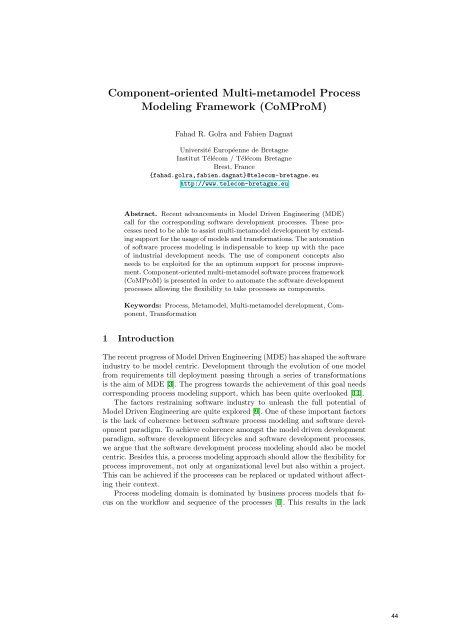A Framework for Integrating ESL Tools - IRIT
A Framework for Integrating ESL Tools - IRIT
A Framework for Integrating ESL Tools - IRIT
You also want an ePaper? Increase the reach of your titles
YUMPU automatically turns print PDFs into web optimized ePapers that Google loves.
Component-oriented Multi-metamodel Process<br />
Modeling <strong>Framework</strong> (CoMProM)<br />
Fahad R. Golra and Fabien Dagnat<br />
Université Européenne de Bretagne<br />
Institut Télécom / Télécom Bretagne<br />
Brest, France<br />
{fahad.golra,fabien.dagnat}@telecom-bretagne.eu<br />
http://www.telecom-bretagne.eu<br />
Abstract. Recent advancements in Model Driven Engineering (MDE)<br />
call <strong>for</strong> the corresponding software development processes. These processes<br />
need to be able to assist multi-metamodel development by extending<br />
support <strong>for</strong> the usage of models and trans<strong>for</strong>mations. The automation<br />
of software process modeling is indispensable to keep up with the pace<br />
of industrial development needs. The use of component concepts also<br />
needs to be exploited <strong>for</strong> the an optimum support <strong>for</strong> process improvement.<br />
Component-oriented multi-metamodel software process framework<br />
(CoMProM) is presented in order to automate the software development<br />
processes allowing the flexibility to take processes as components.<br />
Keywords: Process, Metamodel, Multi-metamodel development, Component,<br />
Trans<strong>for</strong>mation<br />
1 Introduction<br />
The recent progress of Model Driven Engineering (MDE) has shaped the software<br />
industry to be model centric. Development through the evolution of one model<br />
from requirements till deployment passing through a series of trans<strong>for</strong>mations<br />
is the aim of MDE [3]. The progress towards the achievement of this goal needs<br />
corresponding process modeling support, which has been quite overlooked [14].<br />
The factors restraining software industry to unleash the full potential of<br />
Model Driven Engineering are quite explored [9]. One of these important factors<br />
is the lack of coherence between software process modeling and software development<br />
paradigm. To achieve coherence amongst the model driven development<br />
paradigm, software development lifecycles and software development processes,<br />
we argue that the software development process modeling should also be model<br />
centric. Besides this, a process modeling approach should allow the flexibility <strong>for</strong><br />
process improvement, not only at organizational level but also within a project.<br />
This can be achieved if the processes can be replaced or updated without affecting<br />
their context.<br />
Process modeling domain is dominated by business process models that focus<br />
on the workflow and sequence of the processes [1]. This results in the lack<br />
44

















